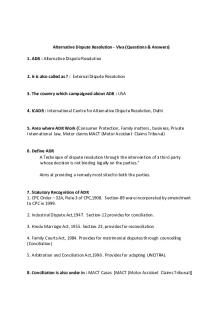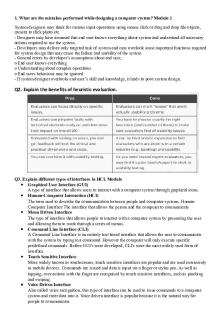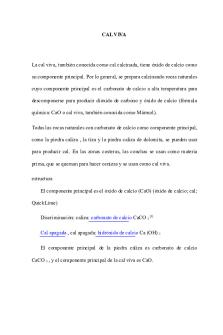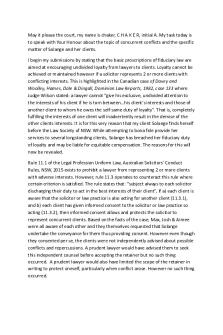Viva Voce Assignment PDF

| Title | Viva Voce Assignment |
|---|---|
| Author | Mariam Achi |
| Course | Professional Responsibility and Legal Ethics |
| Institution | Western Sydney University |
| Pages | 3 |
| File Size | 80.2 KB |
| File Type | |
| Total Downloads | 45 |
| Total Views | 150 |
Summary
May it please the court, my name is Mariam, initial A. It is my task today to speak to your honour about the topic of acting against former clients and the duty pertaining to this. I will address the specific issues regarding Kim and her approaches towards my clients, Todd & Bey, concerning ...
Description
May it please the court, my name is Mariam, initial A. It is my task today to speak to your honour about the topic of acting against former clients and the duty pertaining to this. I will address the specific issues regarding Kim and her approaches towards my clients, Todd & Bey, concerning areas of conflict of interest. I begin my submissions by stating that the basic proscriptions of fiduciary law are not only aimed at encouraging undivided loyalty from lawyers to current clients, but also preserving the duty of confidentiality once the relationship expires. This is highlighted in Rule 10.1 of the Legal Profession Uniform Law, Australian Solicitor’s Conduct Rules, NSW, 2015, that states “a solicitor and law practice must avoid conflicts between the duties owed to current and former clients”. That is, completely fulfilling the interests of one client against a former client will inadvertently result in the demise of the other client’s interests and will incur a breach in confidentiality. It is for this very reason that my clients find themselves before your honour. While attempting to bona fide provide his services to his client Sam by giving the case to Bey, a junior solicitor in his firm, Tod faces the possibility of breaching the duty aforementioned and may need to withdraw from the case. The reasons for this possibility will now be revealed based on two circumstances; first being that Kim is found to be a former client, and the second being that she isn’t. 1. According to the NSW Glossary, the meaning of a former client is a person who “provided confidential information to the solicitor, notwithstanding that the solicitor was not formally retained and did not render an account”. In reference to this, Kim can still be classified a ‘former client’ if she has provided confidential information and my clients’ will have to withdraw from involvement. The main issue at hand is if my client’s law practice, Bey in particular, have information that is detrimental to Kim’s interest if they acted on behalf of Sam. Rule 10.2 asserts that “a solicitor or law practice who or which is in possession of information which is confidential to a former client where that information might reasonably be concluded to be material to the matter of another client and detrimental to the interests of the former client if disclosed”. 2. In prescribing the threshold for judicial intervention in alleged former client conflict cases, the main inquiry focuses on the need to preserve the confidentiality of information and the requirement that the real possibility of misuse of confidential information be to the detriment of the former client protects lawyers from frivolous applications to disqualify. It is significant to establish what constitutes confidential information, which is commonly associated with verbal or written communication. Courts have recognised that impressions of a client’s character, personality and attitudes, obtained from a previous retainer that could subsequently be used to the detriment of that client, are of especial importance in family law. Importantly, the weight of these impressions can carry a higher weight even where the retainers are unrelated, as they pertain to a particular client, not to a particular matter. On the facts of the case, it can be assumed that due to Tod’s engagement with and work on behalf of Kim in the past, as well as his involvement with both parties and their children over a lengthy period, that he would have obtained a substantial amount of confidential information regarding the
nature of their family as well as a significant impression of Kim’s character. As heard in the Court of Appeal in the case of Goldstein v Lee, Rule 5 of the Californian Rules of Professional Conduct aligns with Australian jurisdiction and states that nothing “prohibits an attorney from accepting employment adverse to a former client if the matter has no relationship to confidential information acquired by reason of or in the course of his employment by the former client”. 3.
However, the issue further delves into whether the duty of confidence extends to Bey and if this confidential information has been made available to her. Rule 10.2 of the Australian Solicitor’s Conduct Rules outline exceptions to the previous section and state that no action be taken unless the former client has given informed written consent to the solicitor or law practice so acting; or an effective information barrier has been established. The first exception has not been satisfied due to the lack of provision of written consent from Kim. Despite this, Rule 10.2.2 poses to apply to this matter and the facts of the case infer the possibility of an effective information barrier. Your honour, I will now discuss the role of Chinese Walls, in other words, information barriers, that have been put in place by Tod’s firm to not communicate relevant confidential information, if the court finds that this information is present. As informed by my clients, Tod and Bey have not shared confidential information, as she is in a different practice group on a different floor in their building and is currently working from home because of the corona virus pandemic. This satisfies the Chinese Wall element that there is a physical separation of the various departments to insulate them from each other. Her from-home employment also reduces the likelihood that she has obtained confidential information from other departments in the firm. The Australian Solicitor’s Conduct Rules envisage that an “effective information barrier” can function as an exception to the duty to avoid successive conflicts, and due to this Bey’s mere mechanical modification of the orders can be resumed and found appropriate.
4. Your honour, another issue that prevails in the circumstance that Kim is not found to be a former client of Tod (for he does not consider her a client by merely sharing legal advice and not placing a retainer), is if there is still a conflict of interest through the social connection and engagement between them. A previous social or familial connection between the lawyer and the applicant may involve the communication of confidential information, and thus attract a duty of confidentiality sufficient to justify the lawyer being restrained from later acting against the applicant. As mentioned previously, my client had a social involvement for a lengthy period of time with both the parties and their children and still maintains a close friendship with Sam and the children. In a 1996 judgement from the Canadian authority in Escott v Collision Clinic Ltd, the Newfoundland Supreme Court held that “if the circumstances are such as to warrant a reasonable expectation of confidentiality, the absence of a solicitor-client relationship should not
automatically exclude disqualifying conflict of interest.” Despite Kim not being a former client, there may be another relationship that a duty of confidentiality exists. And if this exists, my client may be disqualified from acting. 5. Moreover, as seen through the Marriage of Kossatz, in Kossatz v Kossatz, a 1993 family law case, a social relationship between a practitioner and former client does not of itself create a conflict when the practitioner acts against the former client. The case also boasts the principles that where a conflict of interest is alleged in family law matters, it must be raised at the earliest opportunity. Furthermore, the honours concluded a failure to take the point initially must also cast doubt on the bona fides of any later complaint concerning the existence of confidential information in the practitioner in question. I submit your honour that had Kim genuinely been concerned about the misuse of confidential information, she would have objected far earlier. After an analysis of the relevant facts and applicable laws to this case, I submit that whether in fiduciary law or case law, no wrong has been committed by my clients against Kim. My client’s continual representation of Sam is valid, as Tod managed to maintain confidentiality and mediate the dispute by handing the case to his trusted junior solicitor Kim and maintained an undivided loyalty and duty of confidentiality when doing so. Accordingly, Kim failed to take the point initially and if she truly fostered mistrust against my client, she should have alerted the parties earlier. My clients will continue to take great care when representing concurrent clients and prevent all issues which may be detrimental to their representations. That concludes my submissions your honour....
Similar Free PDFs

Viva Voce Assignment
- 3 Pages

Viva voce Final
- 19 Pages

Viva Voce Assessment
- 3 Pages

Viva-voce-semiconductors
- 4 Pages

Viva Voce Assessment
- 7 Pages

VIVA VOCE - Lecture notes abcd
- 1 Pages

Case list - Viva voce case list
- 3 Pages

ADR Viva QS - ADR VIVA
- 7 Pages

HMI VIVA - HMI Viva Peparation
- 9 Pages

CAL VIVA - Resumen sobre cal viva
- 14 Pages

VIVA Notes
- 30 Pages

VIVA preparation
- 2 Pages

Java viva
- 13 Pages
Popular Institutions
- Tinajero National High School - Annex
- Politeknik Caltex Riau
- Yokohama City University
- SGT University
- University of Al-Qadisiyah
- Divine Word College of Vigan
- Techniek College Rotterdam
- Universidade de Santiago
- Universiti Teknologi MARA Cawangan Johor Kampus Pasir Gudang
- Poltekkes Kemenkes Yogyakarta
- Baguio City National High School
- Colegio san marcos
- preparatoria uno
- Centro de Bachillerato Tecnológico Industrial y de Servicios No. 107
- Dalian Maritime University
- Quang Trung Secondary School
- Colegio Tecnológico en Informática
- Corporación Regional de Educación Superior
- Grupo CEDVA
- Dar Al Uloom University
- Centro de Estudios Preuniversitarios de la Universidad Nacional de Ingeniería
- 上智大学
- Aakash International School, Nuna Majara
- San Felipe Neri Catholic School
- Kang Chiao International School - New Taipei City
- Misamis Occidental National High School
- Institución Educativa Escuela Normal Juan Ladrilleros
- Kolehiyo ng Pantukan
- Batanes State College
- Instituto Continental
- Sekolah Menengah Kejuruan Kesehatan Kaltara (Tarakan)
- Colegio de La Inmaculada Concepcion - Cebu


